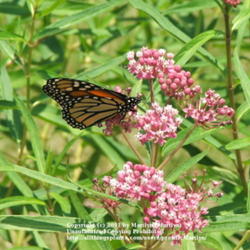

The U.S. Fish and Wildlife Service is now reviewing whether to protect monarchs under the Endangered Species Act.
Monarch butterflies are amazing creatures. These strikingly colored, orange, white, and black butterflies migrate up to three thousand miles every year to spend the winter roosting in large groups in mild winter areas of Mexico and California. Unfortunately, they are also in deep trouble. Over the past twenty years, the number of monarchs has dropped precipitously due in large part to loss of habitat. Logging of Mexican forests has reduced the extent of the butterflies' overwintering sites, and in this country, modern agricultural practices and urban and suburban development have led to loss of important grasslands habitat and a sharp decline in the number of milkweed plants that are vital for monarch reproduction.

Monarch caterpillars display a distinctive pattern of white, yellow, and black bands.
While the adult butterflies feed on nectar from a wide variety of flowers, monarch caterpillars feed exclusively on milkweed. No milkweed means no butterflies. How can you help the beleaguered monarch? By planting milkweed in your own garden and landscape.
Various species of milkweed are found growing natively across the country. While some are wildlings that are best suited to more naturalized landscape areas, there are some species of milkweed that fit nicely into more manicured garden areas.

Butterfly weed is one of the latest perennials to sprout in the spring. Mark its spot so you don't disturb it by accident before it sends up new shoots.
One of the best garden additions is butterfly weed (Asclepias tuberosa), with large, flat-topped clusters of bright orange flowers all summer long on 1-3 foot tall plants. An undemanding, drought tolerant perennial that's native to the eastern and southern U.S. and adapted to USDA Zones 4-9, all it asks is full sun and well-drained soil. Besides helping monarchs, the flowers of butterfly weed also provide nectar to nourish many other species of butterflies. A great choice for a prairie or meadow planting, it pairs nicely with other natives like purple coneflowers, asters, and ornamental grasses.

Swamp milkweed is a great choice for gardens with moist soil, but also does well in soils with average moisture.
Swamp milkweed (Asclepias incarnata) grows naturally in swamps (hence the name), but it also does well in garden settings in full sun in USDA Zones 3-9, adapting to soils with average moisture. A native of the eastern U.S., this milkweed is a robust plant reaching 3-5 feet tall and producing clusters of fragrant pink or mauve flowers through the summer. As with all milkweeds, it will feed monarch caterpillars and attract many species of butterflies.
There are many more native milkweed species that thrive in a variety of climates and growing conditions. Common milkweed (Asclepias syriaca) is one of the most familiar, growing natively in most of the eastern and central U.S. and Canada, but other species are found in just about every region of the country. Here are suggestions for a dozen of the most ornamental native milkweeds from the National Wildlife Federation.
You can also help monarch butterflies by including a variety of flowering plants in your garden so there are blooms from spring to fall to provide nectar for adult butterflies and avoiding the use of pesticides harmful to butterflies and their caterpillars in your gardens and landscape.